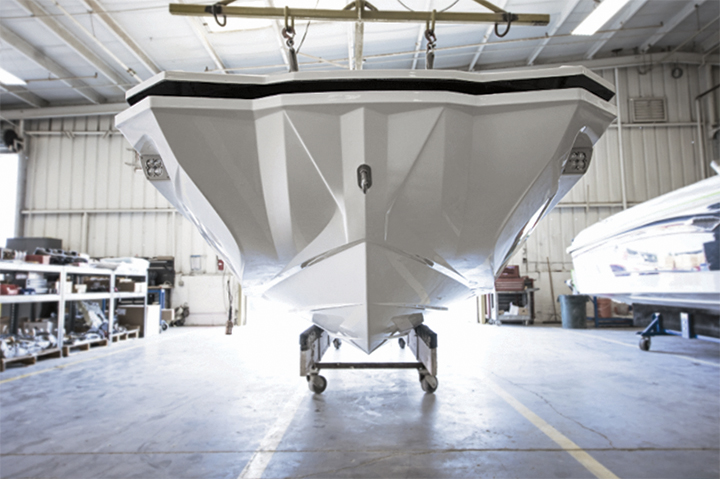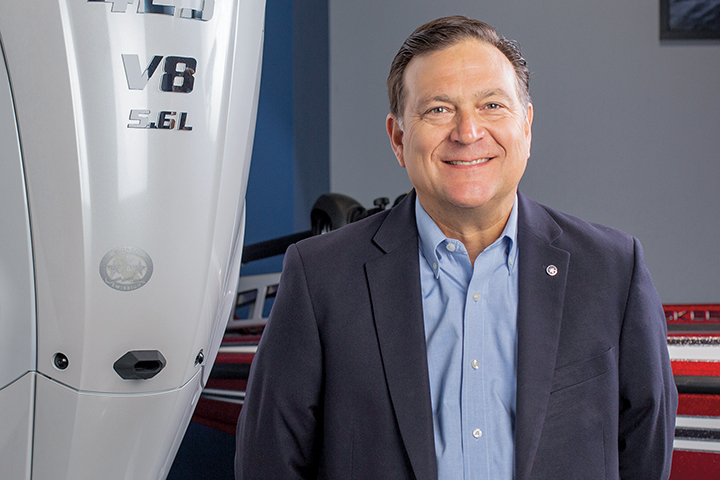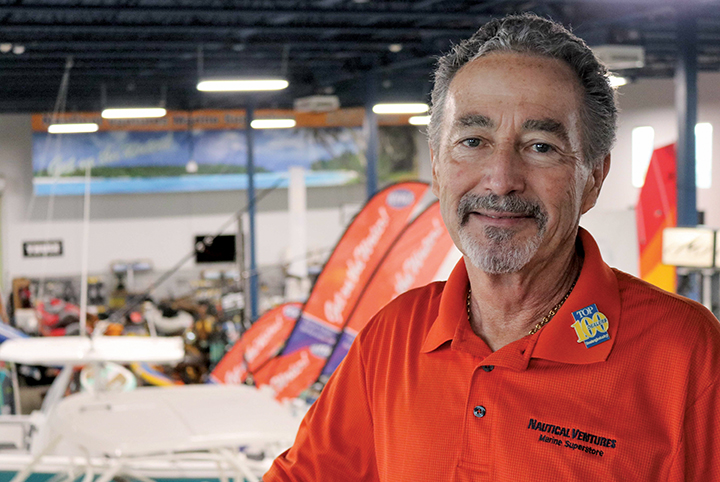Pandemic +1: Where are we now?

By David Gee and Adam Quandt
Global pandemic. Do you remember when you first heard those words? When dealerships closed their doors and production lines shut down did memories of ’07 and ’08 come flooding back like a bad dream? Did you wonder where this was all headed?
Well, we may still be wondering that today, but at least the industry has sold a lot of boats and motors in the meantime! In fact, many of you have sold product that hasn’t even been built yet.
In June of 2020, Boating Industry did a cover story on the pandemic, and we thought it was time to talk to manufacturers and dealers again to find out about supply chain challenges, inventory levels and other critical issues impacting the recreational boating industry.
Sales stay strong
The NMMA reports new boat sales remain healthy, according to the latest New Powerboat Registration Report. Data shows retail unit sales of new powerboats were up 24% on a 12-month year-over-year basis through May.
Pontoons, wake sport boats, runabouts and cruisers led the way up to that point, with YOY increases of between 48%-55%.
“Compared to year-ago levels, sales year-to-date through May were up, buoyed by strong sales this past winter through early spring as manufacturers began to replenish inventory, and inclusive of two months of anemic sales last March and April due to lockdown restrictions in the initial days of the pandemic,” said Ellen Bradley, senior vice president of marketing and communications for NMMA, and a member of the Boating Industry Leadership Council. “However, looking month-to-month, we saw sales dip from April to May across all segments as the industry addresses persistent supply side constraints.”
Brunswick CEO Dave Foulkes detailed some of those challenges in a recent earnings call. He said winter storms and power outages, tight semiconductor supply and material shortages and transportation disruption all had to be dealt with. None of those things lessened retail demand.
“Our 2021 production slots are sold out for the calendar year with five brands completely sold out through the 2022 model year,” said Foulkes. “In fact, the sum of our wholesale orders for 2022 model year product is already roughly equal to our projected 2021 full year wholesale Boat Group revenue.”
The good news doesn’t end there for Brunswick.
“Through the first half of 2021, Brunswick’s average boat buyer’s age continues to be two years younger than the industry average,” continued Foulkes, the 2020 Boating Industry Mover & Shaker of the Year. “Additionally, Brunswick’s first-time boat buyers continue to be younger than our overall boat buyer demographic, and three years younger than the industry average. Also, first-time boat buyers are trending more female than they did in 2020.
“These trends are an extremely important validation of our strategy to secure a healthy future for Brunswick and are also favorable for the entire marine industry,” added Foulkes.
Finding a balance
I don’t know of very many people who spend as much time thinking both about current trends as well as the long-time health of the recreational boating industry as Correct Craft CEO Bill Yeargin.
We had a chance to talk about all that – as well as do some wake surfing – on a recent trip to Orlando.
“A big question impacting the long-term health of our industry will be whether we can keep all the new customers in boating,” Yeargin told me when we got back to the dock. “We know they will have fun on the water so the key factor impacting whether they continue as boat owners will be how their boat ownership experience goes. An already short boating season in many parts of the country combined with so many new boaters is making it very difficult for dealers to keep up with great customer service. Many of the dealers are doing heroic jobs serving customers but we all need to figure out how we can help. It is critical to our industry’s future.”
I asked Yeargin, a long-time Boating Industry contributor and 30-year veteran of the boating industry, when he thought supply was going to catch up with demand, and he said, only half-jokingly I think, “hopefully never.”
“I have heard many projections that indicate it will be 2023 before dealer inventories stabilize and have even heard some say it will be 2024,” Yeargin continued. “Keep in mind that the only way inventories stabilize is if manufacturers are building more boats than are being sold at retail. That’s always a dangerous place to be, even when inventories are low, because it is hard to turn off that excess production once inventories reach their ideal level. The natural result is stuffed pipelines with it being unlikely there will be another black swan event, such as the pandemic, to help empty them out.”
Yeargin says Correct Craft added about 460,000 square feet of production since December to meet demand, but they have also been very careful not to drive up fixed costs.
“This is challenging but the worst mistake is to add capacity for a short-term surge in demand and end up with higher fixed costs that remain when the business cycle transitions,” he said in closing. “That can put a company out of business.”
Martin Bjuve, president of Volvo Penta of the Americas, agrees with the importance of balance for the industry.
“Manufacturers must carefully manage and invest in production to keep up with unprecedented demands, while taking steps to mitigate the risk of overproduction for the instance when levels finally stabilize,” stated Bjuve. “On the wholesale side, we’ve heard from our partners that levels are expected to be stable for another 12-18 months. Navigating the current supply chain requires a mix of relying on trusted long-term suppliers, while also sourcing new partners to secure more flexibility and efficiency.”
Ben Speciale, president, Yamaha U.S. Marine Business Unit, and also a member of the Boating Industry Leadership Council, stated that recreational boating industry sales volume was higher before the Great Recession than it was before COVID, and that the rapid growth in new boat sales in the second half of 2020 and 2021 moved industry volume back to pre-recession highs. That increased volume combined with the challenge of shutdowns led to the inventory gap in the field.
“Retail business has remained brisk, and dealer inventory is very low,” he said. “The package boats dealers receive from plants are retailed right away. As a direct result of COVID last year, the industry lost about 30-60 days of production while the market consumed field inventory. After production restarted, many of the containers used to ship components to the U.S. were on the wrong side of the Pacific. Additionally, as we moved to 2021, consumer demand continued to grow. Then the industry ran into difficulties obtaining resins and other component materials because of the freeze in Texas. This happened as higher unemployment payments kept some workers at home. If there was ever an argument for Murphy’s law, we had it. In 2021 we have continued with very tight timing on all sorts of supplies and labor while we try to meet this higher demand level.”
Speciale added that despite these short-term challenges, he sees a future full of opportunities for the recreational boating industry.
Richard A. Hubbell, the president and CEO of Marine Products (Chaparral, Robalo and Vortex Boats) was certainly excited to release his company’s latest financial results at the end of June.
They saw a net sales increase of 64.8% compared to the same period last year, a 58.8% increase in the number of units sold, as well as a 7.5% increase in average selling price per boat. And gross profit for the second quarter of 2021 was an 86.5% increase compared to the prior year!
“The extraordinarily high demand for our products has continued unabated, and we expect it to remain so beyond the 2021 retail selling season,” stated Hubbell in a company press release.
Dealer details
So how is that 2021 retail selling season going on the dealer side? Glad you asked because we have some answers.
We’re now over a year past the beginning of the COVID pandemic and wrapping up yet another unprecedented summer in the recreational boating industry.
While effects have certainly been felt across the entire industry as a whole, unprecedented demand, new ways of doing business and much more has given boat dealers hurdle after hurdle over the last year-plus.
Despite these hurdles, there’s no doubt boating has become the answer to many people seeking to get out of the house and enjoy time with family, friends and even solo, leading to some of the busiest seasons the industry has ever seen to date.
“It has been absolutely insane to see some of the numbers we’re currently seeing as we head toward fall 2021,” Minnesota-based River Valley Marine owner John Wooden told Boating Industry. “When this whole thing started over a year ago, I would’ve never imagined that boating would’ve taken off in the way that it has.”
Wooden said that River Valley already ended 2020 with revenue and margin up rather significantly, with its net revenue about 2.5-times normal. “Then we jumped into 2021 and somehow some way, we’re already up 120% over 2020, with net profit about 2.5-times above historical normal again,” he added.
Similarly, Maine-based Marina Holdings — made up of Yarmouth Boat Yard, Moose Landing Marina and various Freedom Boat Club locations — is continuing on a record year for 2021.
“Across the board we’re up year-over-year,” owner Steve Arnold said. “We thought 2020 was strong once the boating rush started, but we’re currently sitting 58-60% above 2020 for the year right now across all of our businesses from boat sales to our Freedom Boat Club locations.”
Arnold added that with the recent boating boom over the last year, they also haven’t seen the seasonality that’s usually associated with boat sales.
“We’ve always had demand in the winter, selling about 30% of our boats in the ‘off-season,’ but in the last year, we’re probably 60% over that for winter selling,” Arnold said. “There’s just no off switch on boat buying for customers right now.”
Head down the coast from Maine to Florida and you’ll find yet another similar story of unprecedented demand and a record number of first-time buyers entering the boating world.
“Plain and simple, we’ve enjoyed just a phenomenal year over the last year,” Nautical Ventures Group CEO Roger Moore told Boating Industry.
Moore mentioned that when the pandemic began, Nautical Ventures felt blessed to just be deemed essential due to their work with law enforcement boats. Now a year in, the multi-location dealership is busier than ever from sales to service. “Sales have definitely been robust to say the least,” Moore added.
All three dealers noted that they’ve seen more first-time boat buyers come in over the last year than ever before in their careers selling boats.
“The flood of first-time buyers really kicked off in 2020 and it’s still crazy strong well into 2021 now,” Wooden said. “It’s maybe not the way we intended to bring in new boaters as in industry, but it sure worked. Now we need to work on keeping them in boating.”
While also seeing a run of first-time buyers on the sales side, Arnold noted that he’s also seen a rush of newcomers to his Freedom Boat Club operations.
“People just want to get on the water any way they can and we’ve found that there’s still a large chunk of potential customers out there still not quite ready to buy,” Arnold said. “Freedom Boat Club has been the perfect option for them to get hooked on the boating lifestyle, without some of the headaches that come with boat ownership.”
Yet, while the pandemic itself presented hurdles to dealerships across the country to find new, safe ways of selling and delivering boats and more, the sales boom that followed also brought with it its own set of hurdles to throw at dealers.
Inventory, inventory, inventory
With brief shutdowns in 2020 and the flood of sales that followed, inventory and supply chain are certainly top of mind and the largest hurdle currently facing boat dealers nationwide.
“Inventory is minimal,” Moore said. “We currently have a little of everything, but it’s definitely thin and most of what’s coming in is already pre-sold and headed out the door almost as soon as it gets to us.”
And it’s not just inventory in one area that seems to be lacking. It’s boats, engines, accessories, you name it, it’s likely behind in the supply chain.
“You can only stress a supply chain so much before it breaks down and you could definitely say boating’s broke down,” Arnold said. “Yet, there isn’t just one smoking gun for cause, it was completely across the board.”
Despite buying just about every engine at every opportunity possible, Arnold said that his operations are basically in “survival mode” right now when it comes to engines in stock. “Right now we’re keeping them for the rental fleet, should something break down on that side,” he added.
In Minnesota, Wooden told Boating Industry that he’s had customers come into one of the stores just to see if they’re still in business after fearing the worst after seeing empty lots and showrooms.
“Much like everyone else in the industry right now, we’re stuck waiting on a lot of manufacturer orders,” Wooden said. “And at this point, with how far pre-sold we are, it’s really making things unpredictable and frustrating for both us as a dealer and our customers.”
Communication breakdown
With such a large disparity in inventory and supply chain, communication has been key to dealerships survival through empty showrooms.
“You just have to be upfront with everyone right off the bat,” Moore said. “For the most part, as long as we are transparent as we possibly can be, customers have been very understanding of the situation we’re in.”
While dealers have been in communication with customers to explain some of the recent supply chain issues, some dealers feel like the manufacturers could be doing more to communicate with the dealers themselves about what’s going on from their end.
“We as dealers completely understand that COVID is still a thing and the supply chain is unpredictable right now,” Wooden said. “But if there’s one thing manufacturers could be doing right now, it’s communicating better with their respective dealer networks and in turn the end customer.”
“It’s definitely not anger we’re feeling on the dealer side right now,” Moore explained. “We certainly understand that there are issues and there are valid reasons behind these issues, we’re just feeling frustrated that we aren’t always being communicated with. And it’s not just one OEM, it’s across the board.”
Despite a slight communication break down, dealers are still gearing up the best they can for the business to continue as they head into boat show season.
“They’re definitely going to look different as we get back to in-person boat shows, especially if we don’t have the inventory to display,” Wooden said. “But I believe that boat shows are still necessary to our industry and will continue to play a crucial role to the boating community.”
Moore and his team at Nautical Ventures are gearing up for its largest display yet at the Fort Lauderdale International Boat Show — 44,000 square feet of total display space, a new location for its iconic Aqua Zone and much more. “Despite hurdles facing us as a dealer, we’re rolling forward and ready to keep people engaged in the boating lifestyle,” Moore said.











